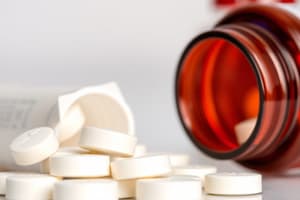Podcast
Questions and Answers
What is the recommended dose of atorvastatin for primary prevention of cardiovascular disease in individuals with a 10% or greater 10-year risk of developing cardiovascular disease?
What is the recommended dose of atorvastatin for primary prevention of cardiovascular disease in individuals with a 10% or greater 10-year risk of developing cardiovascular disease?
- 20 mg (correct)
- 10 mg
- 80 mg
- 40 mg
Statins are not recommended for individuals over 85 years old.
Statins are not recommended for individuals over 85 years old.
False (B)
What are the two primary categories of dyslipidemia?
What are the two primary categories of dyslipidemia?
Primary dyslipidemia and secondary dyslipidemia.
______ is a common non-pharmacological approach to manage dyslipidemia.
______ is a common non-pharmacological approach to manage dyslipidemia.
Which of the following is NOT a type of lipid-lowering drug?
Which of the following is NOT a type of lipid-lowering drug?
Match the lipid-lowering drug with its corresponding mechanism of action:
Match the lipid-lowering drug with its corresponding mechanism of action:
What is the primary mechanism of action for HMG-CoA reductase inhibitors?
What is the primary mechanism of action for HMG-CoA reductase inhibitors?
Atorvastatin is a short-acting HMG-CoA reductase inhibitor.
Atorvastatin is a short-acting HMG-CoA reductase inhibitor.
What is a significant clinical effect of HMG CoA reductase inhibitors?
What is a significant clinical effect of HMG CoA reductase inhibitors?
Fibrates primarily reduce triglyceride levels by 20-30%.
Fibrates primarily reduce triglyceride levels by 20-30%.
What is the mechanism of action of fibrates?
What is the mechanism of action of fibrates?
HMG CoA reductase inhibitors improve ____________ function.
HMG CoA reductase inhibitors improve ____________ function.
Match the following drugs with their primary effects:
Match the following drugs with their primary effects:
What is the primary mechanism of action for Ezetimibe?
What is the primary mechanism of action for Ezetimibe?
Ezetimibe has a half-life of around 10 hours.
Ezetimibe has a half-life of around 10 hours.
What adverse effect is commonly associated with Nicotinic acid (Niacin)?
What adverse effect is commonly associated with Nicotinic acid (Niacin)?
Colestipol prevents the reabsorption of bile acids, diverting hepatic cholesterol to ______.
Colestipol prevents the reabsorption of bile acids, diverting hepatic cholesterol to ______.
Which condition is Nicotinic acid NOT primarily used to treat?
Which condition is Nicotinic acid NOT primarily used to treat?
Match the following cholesterol absorption inhibitors with their characteristics:
Match the following cholesterol absorption inhibitors with their characteristics:
Cholestyramine is contraindicated in breastfeeding.
Cholestyramine is contraindicated in breastfeeding.
What is the principal clinical use of Colestipol?
What is the principal clinical use of Colestipol?
Flashcards
Primary prevention of cardiovascular disease
Primary prevention of cardiovascular disease
Using statins like atorvastatin to prevent heart diseases in high-risk individuals.
Dyslipidaemia
Dyslipidaemia
Abnormal levels of lipids in the blood, often leading to cardiovascular issues.
Lifestyle changes for dyslipidaemia
Lifestyle changes for dyslipidaemia
Non-pharmacological strategies such as diet, exercise, and quitting smoking.
HMG-CoA reductase inhibitors
HMG-CoA reductase inhibitors
Signup and view all the flashcards
Atorvastatin
Atorvastatin
Signup and view all the flashcards
Simvastatin
Simvastatin
Signup and view all the flashcards
Long-lasting vs Short-acting Statins
Long-lasting vs Short-acting Statins
Signup and view all the flashcards
Secondary dyslipidaemia
Secondary dyslipidaemia
Signup and view all the flashcards
Fibrates
Fibrates
Signup and view all the flashcards
Mechanism of action of fibrates
Mechanism of action of fibrates
Signup and view all the flashcards
Rhabdomyolysis
Rhabdomyolysis
Signup and view all the flashcards
Adverse effects of fibrates
Adverse effects of fibrates
Signup and view all the flashcards
Ezetimibe
Ezetimibe
Signup and view all the flashcards
NPC1L1
NPC1L1
Signup and view all the flashcards
Bile acid sequestrants
Bile acid sequestrants
Signup and view all the flashcards
Colestipol
Colestipol
Signup and view all the flashcards
Niacin
Niacin
Signup and view all the flashcards
Adverse effects of Niacin
Adverse effects of Niacin
Signup and view all the flashcards
Cholesterol absorption inhibitors
Cholesterol absorption inhibitors
Signup and view all the flashcards
Half-life of Ezetimibe
Half-life of Ezetimibe
Signup and view all the flashcards
Study Notes
Lipid Lowering Drugs for Cardiovascular Disease Prevention
- Lipid-lowering drugs are used to treat cardiovascular disease.
- People at risk of early death from cardiovascular disease should have lifestyle changes and lipid modification therapy.
- Identifying and assessing cardiovascular disease risk is a key aspect of prevention.
Primary Prevention of Statins in Cardiovascular Disease
- Offer atorvastatin 20 mg for primary prevention of cardiovascular disease to people with a 10% or greater 10-year risk of developing cardiovascular disease.
- For people aged 85 and older, consider atorvastatin 20 mg, as statins may reduce the risk of non-fatal myocardial infarction.
- Primary dyslipidemia is a combination of dietary and genetic factors. Familial hypercholesterolemia (FH) is a high risk for coronary heart disease (CHD).
- Secondary dyslipidemia is a consequence of other conditions like diabetes, alcoholism, and renal disease.
Treating Dyslipidemia Pharmacologically and Non-Pharmacologically
- Non-pharmacological methods include a cardioprotective diet, weight loss, physical activity, and reduced alcohol consumption and smoking cessation.
- Pharmacologically, anti-hyperlipidaemic drugs are used.
Different Lipid Lowering Drugs
- HMG-CoA reductase inhibitors
- Fibrates
- Cholesterol absorption inhibitors (Ezetimibe & Bile-acid binding resins)
- Omega fatty acids
- Nicotinic acid
HMG-CoA Reductase Inhibitors
- Simvastatin, Pravastatin, Lovastatin, Atorvastatin, Rosuvastatin, and Fluvastatin are examples.
- They block HMG-CoA reductase, a crucial enzyme in cholesterol synthesis.
- Short-acting and specific inhibitors include Simvastatin and Lovastatin.
- Long-lasting inhibitors include Atorvastatin.
- These drugs increase LDL receptor synthesis and increase LDL clearance.
- They are mostly short-acting and oral, typically taken at night.
- Liver metabolism, primarily by CYP450s, is a key aspect, with some exceptions.
- Clinical use includes preventing FH, reducing LDL (30%) and increasing HDL (20%), providing secondary prevention for MI and stroke.
- Potential adverse effects include muscle pain and gastrointestinal problems.
Beneficial Effects of HMG-CoA Reductase Inhibitors
- Improved endothelial function
- Improved vascularisation of ischaemic tissue
- Atherosclerotic plaque stabilisation
- Reduction in vascular inflammatory response
- Reduction in platelet activation
- Enhanced fibrinolysis
- Antithrombotic properties
Fibrates
- Gemfibrozil, Fenofibrate, Bezafibrate are examples.
- They act as agonists at peroxisome-activated receptor-alpha (PPAR-alpha).
- They increase lipoprotein lipase synthesis, increase fatty acid oxidation, and increase LDL uptake.
- They reduce VLDL and TG, with modest reduction in LDL.
- They can be helpful for hypertriglyceridemia and mixed hyperlipidemia.
- Metabolized by CYP450s and renal excretion is common.
- Potential adverse effects include rash, gastrointestinal problems, and rare cases of rhabdomyolysis (muscle breakdown) potentially leading to kidney damage.
Cholesterol Absorption Inhibitors
- Ezetimibe, is used to inhibit cholesterol absorption.
- It works by affecting Niemann-Pick C1-like 1 (NPC1L1) transport protein.
- It's absorbed into intestinal cells.
- Clinical use for hyperlipidemia often in combination with statins.
- Adverse effects include mild diarrhea and abdominal pain.
Colestipol and Cholestyramine, Cholesterol Absorption Inhibitors
- These bind to bile acids in the gut, preventing reabsorption.
- They increase LDL receptors, thus increasing LDL removal from the blood.
- They are administered orally.
- Clinical Use is for primary hypercholesterolemia.
- Associated potential adverse effects include constipation, bloating, malabsorption of certain vitamins and minerals.
Nicotinic Acid (Niacin)
- Reduces VLDL synthesis in the liver.
- Reduces hormone-sensitive lipase activity in adipose tissue.
- Increases HDL levels.
- Increases VLDL and TG clearance.
- It's readily absorbed, metabolized in the liver, and excreted via the kidneys.
- Clinical use is for hypercholesterolemia and hypertriglyceridemia, particularly with low HDL levels.
- Common adverse effects include flushing and pruritus (itchiness).
Studying That Suits You
Use AI to generate personalized quizzes and flashcards to suit your learning preferences.





